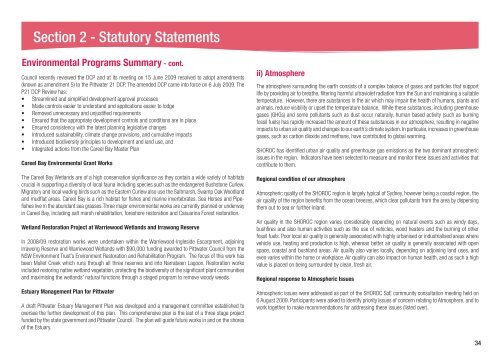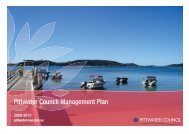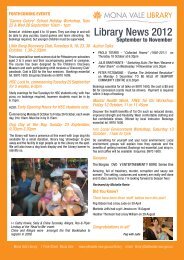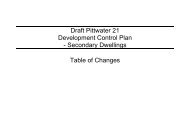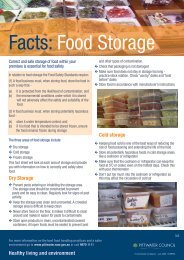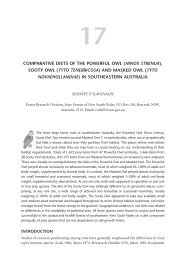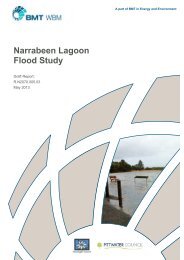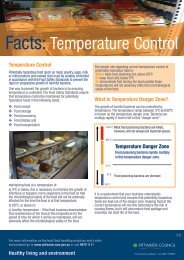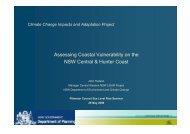Pittwater Council Annual Report - Pittwater Council - NSW ...
Pittwater Council Annual Report - Pittwater Council - NSW ...
Pittwater Council Annual Report - Pittwater Council - NSW ...
- No tags were found...
You also want an ePaper? Increase the reach of your titles
YUMPU automatically turns print PDFs into web optimized ePapers that Google loves.
Section 2 - Statutory StatementsEnvironmental Programs Summary - cont.<strong>Council</strong> recently reviewed the DCP and at its meeting on 15 June 2009 resolved to adopt amendments(known as amendment 5) to the <strong>Pittwater</strong> 21 DCP. The amended DCP came into force on 6 July 2009. TheP21 DCP Review has:• Streamlined and simplified development approval processes• Made controls easier to understand and applications easier to lodge• Removed unnecessary and unjustified requirements• Ensured that the appropriate development controls and conditions are in place• Ensured consistency with the latest planning legislative changes• Introduced sustainability, climate change provisions, and cumulative impacts• Introduced biodiversity principles to development and land use, and• Integrated actions from the Careel Bay Master PlanCareel Bay Environmental Grant WorksThe Careel Bay Wetlands are of a high conservation significance as they contain a wide variety of habitatscrucial in supporting a diversity of local fauna including species such as the endangered Bushstone Curlew.Migratory and local wading birds such as the Eastern Curlew also use the Saltmarsh, Swamp Oak Woodlandand mudflat areas. Careel Bay is a rich habitat for fishes and marine invertebrates. Sea Horses and Pipefisheslive in the abundant sea grasses.Three major environmental works are currently planned or underwayin Careel Bay, including salt marsh rehabilitation, foreshore restoration and Casuarina Forest restoration.Wetland Restoration Project at Warriewood Wetlands and Irrawong ReserveIn 2008/09 restoration works were undertaken within the Warriewood-Ingleside Escarpment, adjoiningIrrawong Reserve and Warriewood Wetlands with $90,000 funding awarded to <strong>Pittwater</strong> <strong>Council</strong> from the<strong>NSW</strong> Environment Trust’s Environment Restoration and Rehabilitation Program. The focus of this work hasbeen Mullet Creek which runs through all three reserves and into Narrabeen Lagoon. Restoration worksincluded restoring native wetland vegetation, protecting the biodiversity of the significant plant communitiesand maximising the wetlands’ natural functions through a staged program to remove woody weeds.Estuary Management Plan for <strong>Pittwater</strong>A draft <strong>Pittwater</strong> Estuary Management Plan was developed and a management committee established tooversee the further development of this plan. This comprehensive plan is the last of a three stage projectfunded by the state government and <strong>Pittwater</strong> <strong>Council</strong>. The plan will guide future works in and on the shoresof the Estuary.ii) AtmosphereThe atmosphere surrounding the earth consists of a complex balance of gases and particles that supportlife by providing air to breathe, filtering harmful ultraviolet radiation from the Sun and maintaining a suitabletemperature. However, there are substances in the air which may impair the health of humans, plants andanimals, reduce visibility or upset the temperature balance. While these substances, including greenhousegases (GHGs) and some pollutants such as dust occur naturally, human based activity (such as burningfossil fuels) has rapidly increased the amount of these substances in our atmosphere, resulting in negativeimpacts to urban air quality and changes to our earth’s climate system. In particular, increases in greenhousegases, such as carbon dioxide and methane, have contributed to global warming.SHOROC has identified urban air quality and greenhouse gas emissions as the two dominant atmosphericissues in the region. Indicators have been selected to measure and monitor these issues and activities thatcontribute to them.Regional condition of our atmosphereAtmospheric quality of the SHOROC region is largely typical of Sydney, however being a coastal region, theair quality of the region benefits from the ocean breezes, which clear pollutants from the area by dispersingthem out to sea or further inland.Air quality in the SHOROC region varies considerably depending on natural events such as windy days,bushfires and also human activities such as the use of vehicles, wood heaters and the burning of otherfossil fuels. Poor local air quality is generally associated with highly urbanised or industrialised areas wherevehicle use, heating and production is high, whereas better air quality is generally associated with openspace, coastal and bushland areas. Air quality also varies locally, depending on adjoining land uses, andeven varies within the home or workplace. Air quality can also impact on human health, and as such a highvalue is placed on being surrounded by clean, fresh air.Regional response to Atmospheric IssuesAtmospheric issues were addressed as part of the SHOROC SoE community consultation meeting held on6 August 2009. Participants were asked to identify priority issues of concern relating to Atmosphere, and towork together to make recommendations for addressing these issues (listed over).34


